Golden Paper Wasp
Polistes aurifer
Classification
- Phylum: Arthropoda
- Subphylum: Hexapoda
- Class: Insecta
- Order: Hymenoptera
- Superfamily: Vespoidea
- Family: Vespidae
- Subfamily: Polistinae
- Genus: Polistes
- Species: aurifer
Pronunciation
How to pronounce Polistes aurifer: //pəˈlɪstiːz ˈɔːrɪfər//
These audio files are automatically generated. While they are not always 100% accurate, they are a good starting point.
Images
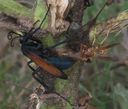
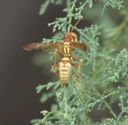
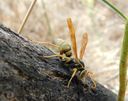

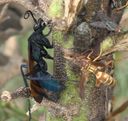
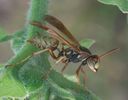
Summary
Polistes aurifer, known as the golden paper wasp, is a species prevalent in the western regions of North America, recognized for its distinct coloration and nesting behavior. It is a eusocial wasp that plays significant roles in ecological interactions, though its conservation status remains unevaluated by IUCN.
Physical Characteristics
Morphological differences include male genital structure and variable color patterns depending on geographic location. Northern specimens are often mostly black with yellow markings, while southwestern populations may exhibit yellow metasoma. Ferruginous coloration varies among populations.
Identification Tips
Distinguished from P. fuscatus by the ferruginous dorsal surface of the first flagellomeres which is dark in P. fuscatus. P. aurifer often shows yellowish wings and characteristic yellow patches on the second tergum.
Habitat
Nests in sheltered locations, primarily in wooded or vegetated areas.
Distribution
Found throughout western North America, including British Columbia, Alberta, Saskatchewan, Arizona, California, Colorado, North Dakota, South Dakota, Idaho, Kansas, Montana, Nebraska, Nevada, New Mexico, Oregon, Texas, Utah, Washington, Wyoming, and northern Mexico. Adventive populations reported in Hawaii and the Society Islands, and a record in Prince Edward Island, Canada.
Diet
Typically feeds on nectar and insects, playing a role in pollination and pest control.
Reproduction
Eusocial species with a colony structure. Nest building and reproduction occur primarily in warmer months.
Conservation Status
Not evaluated by the IUCN.
Ecosystem Role
May contribute to pollination and control of pest insect populations.
Evolution
Originally described by Henri Louis Frédéric de Saussure in 1853. Subject to taxonomic revisions including synonymization and consideration as a subspecies of P. fuscatus.
Similar Taxa
Misconceptions
Commonly confused with P. fuscatus and P. apachus due to similar coloration in certain individuals.
Tags
- wasp
- insect
- Polistes
- eusocial
- pollinator